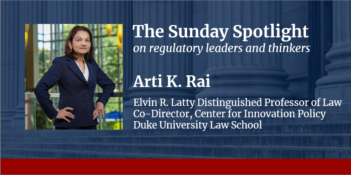
Scholar argues that patents do not—and should not—compensate for the costs of drug development.
Compared to consumers in other high-income countries, U.S. consumers pay significantly more for prescription drugs. Research shows that patents are one of the greatest drivers of these prices. Because patents give drug companies the right to exclude others from making and selling their products, they offer a key incentive for innovation: Not only can no one else profit from the invention for the duration of the patent term, the patent holder can price its drugs at a higher price point than if they had competitors.
The market exclusivity that pharmaceutical patents bestow on their owners is a topic of ongoing debate. Some observers question whether they have any place in health care at all, while others wonder what their scope should be.
In a recent article in the Yale Journal of Health Policy, Law, and Ethics, Robin Feldman of University of California School of Law, San Francisco challenges the understanding that beyond rewarding successful contributions to society—what Feldman contends is the true object of the patent system—patents should also compensate for the costs of drug research and development.
A patent, Feldman argues, “is not a participation trophy.” But many observers currently understand the patent system to remunerate effort rather than only rewarding achievement. The result Feldman describes is a patent system that creates incentives for failure—for, beyond the costs associated with the nonsuccesses of the patented product itself, under this modern approach, patents cover failures of the patent holder’s other failed products as well. Put differently, the dollar amount that patents currently allow their owners to recoup is far greater than the costs incurred by the patented invention itself.
Feldman blames Congress, academia, and courts for this misguided approach to patents. She cites a Congressional Budget Office report, congressional testimony, multiple scholarly publications, and two court decisions to illustrate her point. In one of the cases Feldman cites, for example, the majority opined that drugmakers should be able to recoup sufficient returns from successful drugs “to make up for the losses from drugs that never make it to market.” In the other case, the court declared that patents should remunerate development costs for even those products that do make it to market “but never recoup the costs associated with their getting there.”
Feldman makes both a descriptive and a normative argument against the idea that patent rewards should compensate for development costs. Descriptively, Feldman notes that such an understanding does not comport with patent law as it was originally conceived. And normatively, she argues that it should not be the governing approach to patents in health care.
As a descriptive matter, Feldman argues that patent remuneration of development costs was completely absent in the early history of American patent law, demonstrating its incompatibility with congressional intent and common law. In fact, she notes that early lawmakers stated plainly that development costs are “irrelevant to patentability.”
To illustrate this point, Feldman spotlights the Patent Term Extension Provision of 1836 and, in particular, its repeal. The Provision authorized the U.S. Patent Office to grant a seven-year extension to a patent if its term was insufficient to allow the patent holder to recoup development costs. Yet Feldman observes that it was fleeting and thus a “failed experiment,” the 1861 repeal of which evinces a rejection of the idea that patents should cover development costs. Furthermore, she notes, even while it was in place, the patent extension only remunerated the patented invention itself, and not the costs of the patentee’s other products. Finally, Feldman points out that the Patent Office issued only 10 extensions under the Provision, the infrequency of which underscores the Office’s reluctance to invoke the provision.
Early patent law notwithstanding, Feldman makes the normative argument that patent rewards ought to exclude development costs. She argues that a patent system should be “agnostic” to “the costs of an endeavor.” Using patent rewards to compensate research and development costs, Feldman explains, creates perverse economic incentives that ultimately promote inefficiency, encourage failure, and threaten “to cost society dearly.”
Feldman illustrates her point with a hypothetical: Two pharmaceutical companies have each acquired several drug candidates. The first company purchased two and the second five, all for the same per-unit price. Only one drug from each company makes it to market, meaning that the second company has spent more than twice what the first did for the same number of successes.
According to the view that patents should compensate development costs, the second company would be justified in earning over twice as much as the first to produce the same value to society—a profit that would be enabled by the successful drug’s patent. Consequently, the company that incurs more failures earns more money, for the patent system in which it operates ensures that “failure,” Feldman writes, “begets more failure.”
Feldman posits that compensating for development costs means compensating for failures, which means more failures translate to higher price tags. As she explains, additional forces in the pharmaceutical industry exacerbate this effect. Key among these forces is the “historic shift” in the industry toward outsourcing innovation and away from internal development, she notes. Feldman explains that drug companies increasingly secure patents on the drugs that have already undergone early-stage development—the highest-risk stage of innovation.
The resulting market, Feldman illustrates, is one in which the patent owner is “over-rewarded,” true “innovators are under-rewarded,” and the incentive to engage in high-risk research is weakened. Thus, an approach to patents that compensates for development costs not only prioritizes the patent owner over society, but fails even to direct incentives to the true innovator.
Rather than “compensate for attempts gone bad,” Feldman argues, patent rewards “must be firmly and solely rooted in the successful invention alone.” She maintains that at its core, patent law has always prioritized benefits to society over benefits to inventors. The current dominant paradigm of patents—one that rewards not only successful inventions but also compensates for failures—is, then, at odds with and unfaithful to “the dictates of patent law’s underlying theory,” Feldman exclaims.



